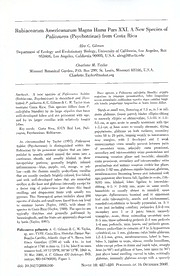
Rubiacearum Americanarum Magna Hama Pars XXI. A New Species of Palicourea (Psychotrieae) from Costa Rica PDF
Preview Rubiacearum Americanarum Magna Hama Pars XXI. A New Species of Palicourea (Psychotrieae) from Costa Rica
Rubiacearum Americanarum Magna Hama Pars XXL A New Species of Palicourea (Psychotrieae) from Costa Rica Alex C. Gilman Department of Ecology and Evolutionary Biology, University of California, Los Angeles, 951606, Los Angeles, California 90095, U.S.A. [email protected] Charlotte M. Taylor Missouri Botanical Garden, P.0. Box 299, St. Louis, Missouri 63166, U.S.A. [email protected] A(Rbusbtriaaccet.a e, AP snyecwh otsrpieeacei)e si s ofd ePsactr ibed aan dA iullbulse¬t laHjoareibc uss peicni esv eatu sPtaatleic opuerersai stseanlitcibifuosl,i a fSobta’ins dleloyn gsiloipriubluiss trated: P. palustris A. C. Gilman & C. M. Taylor from ris lobulis proportione longioribus ac fauce latiore differt. smwlacoaoneobludKilnecrl ee-stiaydb.fa o ny,e welv Pi eaoistCl rysodSco pshts:lea toadanrt rdgCiRlleeoeoaribysc ete a,ca sb. o RyrTRa uonhiibltcldisiaasa s, cal saerIpwraeUgee ieC.ctp h iNee srs trsi eipRdsluateiefltdeifn vestre Lsltwi yhsf iatrt,th ol o mPhnaaa gglvPiee¬e.r, pv1tyae-e i1pSrnnny.has5srr r aur1gccob 8lew a ooblturyor so s,2uem 4lslga. i llpplaL tabtieircrareo vseuo,e ,ssr l folpooooabnwpuil irasenebunrgdioacn ;lte wglhoyb el alaaasattk udce1lreu,y.f sm5a 5 ctieom.en5l sla,i-i; ntp 1teott5s ei ecy 5r c-c,¥ oo%omdb nnr lLdyntoaaiSenrlr^cl gy;ft S ARpciiltasaspststhbonnhovowwe nppyuyuuwfta tpnAdeeerdl obmbeitoeit— cobcmr lesllicilnplarimeai niinwiaeeeearoretencwuslnd secssirnsitelgeon t ci isyi.ta;htoor(a iugu eat hnPec ftoTl(sbnnsr uaTs i auswietchCdnrytmrbhnaha ueh iidgecsoyyesdrlssssefhslh lu ls t—u lopyco, ybeotN-bo iaarro rdaltafdatsfeis,lo sberlrtn eb slr iRosi thouyluaemv1eidetpwup,otssi n ap9ed ruce i aneteeduola9l ah,bonrrsa)a cnp(7 sse e;abpsrdTne(ii) i lpsmnytceT .sofadyie cgudu ardtsyau gadeeul sl rb lyTlsa en npuoilurl tbntdg acrtloaiasgsute ,greeyiefl rrur ebos,lrar,hnseo l ya tnuaoeutre1tuiuj1li eellsinrsrusl9pslnyt9 r eypy gs s9uaad i8fd e i(tuntc7poll 9nh 1,ldeiot)uw pby)tcase9sb,ail.hna ih lctro 9oibrlu erntdTeeior7rwtohe gdea haldpabh)vf nlhidelns,ar oraeetel ttetos,uhgtyllt de l w ylemP ysse fm itaa;pu ie,n aish a vd brtxsaeoiaslihbeeinoi clcsemctocsc io-le o uieainorpylonuedie rotp l bne tLu oslwt obhtey rat o2lr ttreseheveals fwhee03aberldoaarieaed¬a0-o1syrde,trll pniosrcpa8bo(cid:9632)tl3r6tsn1eeerefroeogr(ebr u tmi-ecto1a-aasueccelai4 noof0tmorin,monrnaas cn n)slcpndibge mmei aeandghnd peecusmtxc,(iammlud omerar lnnoier7soan.arl-nl;o,yg4nt moiycs -r m rsdst t, d3gou- p I ht,aa5in airse2ev(nornnya frja nadty e esldsbyocmalxtomnu e,ntXu i n eJeral nab itmt eodsvsrn,tvfeciu s nuibew btft,2e,lo1csse oeab tieeeieeg-uinnetrrt1rn cd,ttt3n ci lsrma she^hlovsa,t(oce eal n ,iopbm4el ec naaxuodyslrlst)olvrdeyioasroei 1 oy>nnns eaau ,n ubr ,mtgsddr gaob eseesvy 2 1aal bs;drb mfrusl1pe bxoeramry steabanyare,usaliat v oltnaipnasid clds),epenwipl vid taaeditlglnlulliacsyrecyi e ooinudlpr,elegiiu e pn snnlisieltputsa;anans eoaesteda ylnct envdgv l nn aneu2arodrpdi idtt adbnsosms-se rr smei3 rincootp ibatbbeaaictn ol tmueinonielccle ron mddenedsi tadotsin cwoo au,sdinr mn l phdc lv,mbarueued 2,reoaa;anua gdpelo2 ae.lrttntobpcctl5,pnso em ery aaauaey ee d,-m pbsr .xiogs3d rwv rp(tnslr moirloei aw5eoia5aaeaaeecunrcwnix) uinlotneaieinmsurl6eetelstlnsXkdyl)shsey,s-;-s,st,;. Palicourea palustris A. C. Gilman & C. M. Taylor, Flowers pedicellate in cymules of 3 to 5; hypanthium sp. nov. TYPE: Costa Rica. Heredia: Parque Nac. cylindrical, ca. 1 mm, glabrous; calyx limbs glabrous, Braulio Carrillo, Atlantic slope of V. Barva, from 1.2-1.5 mm, green, membranaceous, lobed to base, Finca Gourdian (1700 m) walk 4 hr. to tent lobes 5, ligulate to ovate, obtuse; corolla funnelform, refugia at 1740 m then ea. 1.5 hr. hike S on main white except yellow in throat and inside tube, strongly transect trail, 10°11'29"N, 84°06'12"W, 1860 m, bent (to 90°) and gibbous at base, bent again (to 90°) 31 Mar. 2005, A. C. Gilman 420 (holotype, INB; just above basal swelling, curved in tul e t tally isotype, MO 04796838). Figure 1. glabrous, internally glabrous except with a sparsely doi: 10.3417/2006100 Novon 18: 487^89. Published on 16 December 2008. & Taylor
